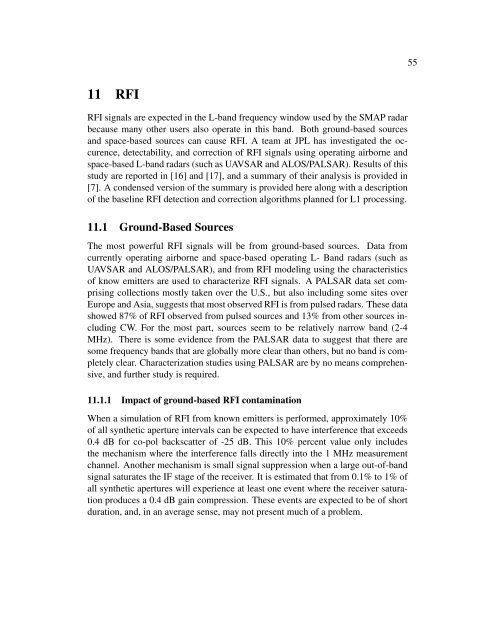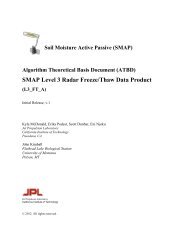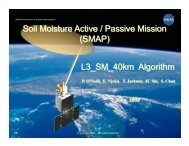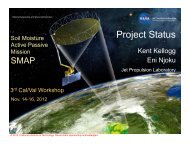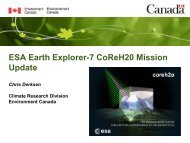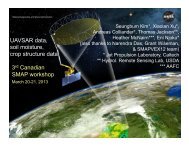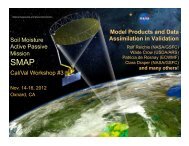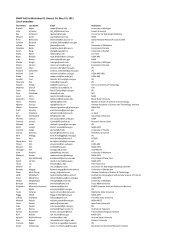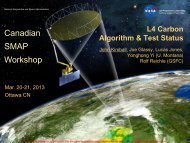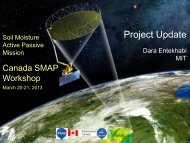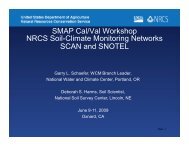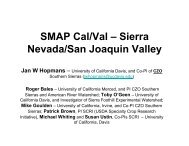(ATBD) SMAP Level 1 Radar Data Products - NASA
(ATBD) SMAP Level 1 Radar Data Products - NASA
(ATBD) SMAP Level 1 Radar Data Products - NASA
Create successful ePaper yourself
Turn your PDF publications into a flip-book with our unique Google optimized e-Paper software.
55<br />
11 RFI<br />
RFI signals are expected in the L-band frequency window used by the <strong>SMAP</strong> radar<br />
because many other users also operate in this band. Both ground-based sources<br />
and space-based sources can cause RFI. A team at JPL has investigated the occurence,<br />
detectability, and correction of RFI signals using operating airborne and<br />
space-based L-band radars (such as UAVSAR and ALOS/PALSAR). Results of this<br />
study are reported in [16] and [17], and a summary of their analysis is provided in<br />
[7]. A condensed version of the summary is provided here along with a description<br />
of the baseline RFI detection and correction algorithms planned for L1 processing.<br />
11.1 Ground-Based Sources<br />
The most powerful RFI signals will be from ground-based sources. <strong>Data</strong> from<br />
currently operating airborne and space-based operating L- Band radars (such as<br />
UAVSAR and ALOS/PALSAR), and from RFI modeling using the characteristics<br />
of know emitters are used to characterize RFI signals. A PALSAR data set comprising<br />
collections mostly taken over the U.S., but also including some sites over<br />
Europe and Asia, suggests that most observed RFI is from pulsed radars. These data<br />
showed 87% of RFI observed from pulsed sources and 13% from other sources including<br />
CW. For the most part, sources seem to be relatively narrow band (2-4<br />
MHz). There is some evidence from the PALSAR data to suggest that there are<br />
some frequency bands that are globally more clear than others, but no band is completely<br />
clear. Characterization studies using PALSAR are by no means comprehensive,<br />
and further study is required.<br />
11.1.1 Impact of ground-based RFI contamination<br />
When a simulation of RFI from known emitters is performed, approximately 10%<br />
of all synthetic aperture intervals can be expected to have interference that exceeds<br />
0.4 dB for co-pol backscatter of -25 dB. This 10% percent value only includes<br />
the mechanism where the interference falls directly into the 1 MHz measurement<br />
channel. Another mechanism is small signal suppression when a large out-of-band<br />
signal saturates the IF stage of the receiver. It is estimated that from 0.1% to 1% of<br />
all synthetic apertures will experience at least one event where the receiver saturation<br />
produces a 0.4 dB gain compression. These events are expected to be of short<br />
duration, and, in an average sense, may not present much of a problem.


